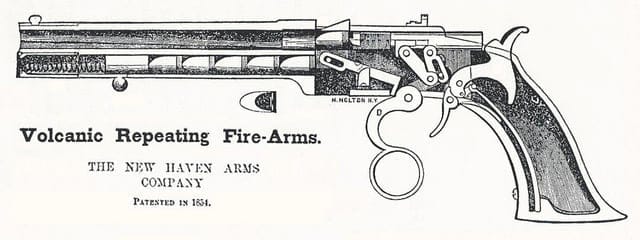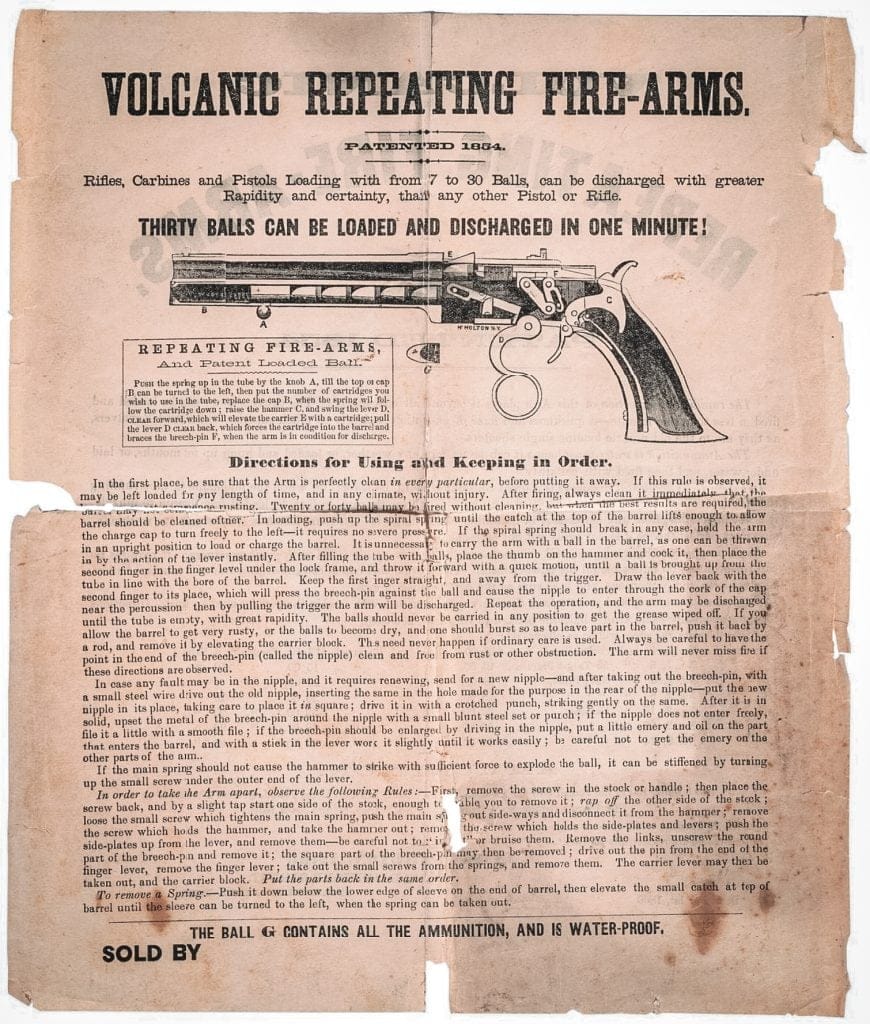At SHOT Show 2024, Smith & Wesson surprised everyone with the S&W 1854 lever-action rifle. S&W revealed the .44 Magnum lever-action rifle to a fair amount of fanfare. They revealed the standard stainless steel and black model, as well as a wood and blued steel design and an even more limited-edition design that pairs the rifle with a Model 29 handgun and plenty of fancy gold inlay. Part of their marketing was the return to Smith & Wesson’s historical roots and naming the gun the Model 1854.

That’s odd since S&W wasn’t formed until 1856 when Horace Smith and Daniel B. Wesson teamed up with Colt employee Rollin White to create a bored-through cylinder revolver. In fact, the S&W company was never known for its lever guns. They were a revolver company and, to this day, remain a revolver company, so how did they return to their roots exactly?
Before Horace Smith and Daniel B. Wesson formed S&W, they created a short-lived company known as Volcanic Repeating Arms. To be completely fair, it was known as the Smith and Wesson company, just not for very long. Volcanic is likely mostly known by players of Red Dead Redemption 2 and not many other people. However, when S&W starts talking about its roots, it is specifically addressing the Volcanic Arms Company and its rather revolutionary but unsuccessful lever gun.
The Volcanic Repeating Arms Company
There they were, a young Horace Smith and Daniel B. Wesson. Before their names became American icons, the two men were gunsmiths. In fact, when Daniel Wesson proposed to his soon-to-be wife, her father opposed the engagement as he was a mere gunsmith. Prior to becoming a household name, Horace Smith served with various gun makers and even invented an exploding bullet to kill whales.
The two men teamed up in 1854 with the goal of developing a third man’s ammunition and repeating firearm. The third man was Walter Hunt. He’s better known for inventing the sewing machine, the safety pin, and several more devices. He designed the ammo in 1848 and the first rifle in 1849. It bears mentioning that while Hunt invented a variety of items, he was not a manufacturer.

Prior to working with Smith & Wesson, the rifle and ammo design was licensed to Lewis Jennings, who worked on the action. These became known as the Jennings rifles. They still weren’t great, so in 1850, one of the investors of the Jennings rifle approached Horace Smith and asked him to improve the rifle. Smith did and produced a run of the rifles.
By 1851, the original investors couldn’t see the design turning a profit and flatlined the project. It wasn’t until 1852, when Smith met Wesson, that they began tinkering with the idea of a repeating pistol, which eventually became known as the Volcanic. In 1854, they formed the Volcanic Repeating Arms Company with the help of one of the former investors of the Jennings rifle.
The Volcanic Pistols and Rifles
The Volcanic designs were lever-action guns. They weren’t much different than the lever guns of today. A tubular magazine held the ammunition under the barrel, and a lever would act as the mechanism to load the next round and cock the hammer. Unlike modern lever actions, this gun did not eject a case. Volcanic produced both handguns and rifles with this mechanism.

For the era, this was rather revolutionary. The handguns and rifles fired several rounds without pause and could be reloaded quicker than any weapon on the market. While Colt held onto the patent for revolvers, the Volcanic offered a fairly intriguing alternative. Revolvers of the era were percussion cap designs that were slow to reload.
The Volcanic uses a type of caseless ammo that packs the bullet, propellant, and primer into one package. The Volcanic used a Hunt Rocketball cartridge, which utilized a projectile similar to the Minie ball. However, they packed the hollow rear portion with propellant and sealed it with an exposed primer. When fired, the primer would eject from the projectile. Not only was this an early form of metallic cartridge, but it was the first caseless ammo ever to exist.

This meant faster reloads and a higher capacity. The pocket pistol version held ten rounds, the target model held 10, and the carbines could hold anywhere from 18 to 30 rounds depending on their barrel length. As we know now, the lever action design allows the weapon to cycle fairly quickly. For the era, it was a rather revolutionary design. The caseless ammunition idea likewise would not be repeated until relatively recently.
Why We Never Heard of It
Although revolutionary, the Volcanic rifles, pistols, and Rocketball ammo were seemingly abandoned. The big question is, why? Well, while the idea was revolutionary, the results weren’t great. The main problem was the anemic performance of the Rocketball ammo.
The rounds were .31 and .41 caliber but ultimately were terrible ballistically. There isn’t a lot of room in the case to pack propellant, so the rounds could not move fast or far. The projectiles had about the same amount of power as the .25 ACP. The .25 ACP cartridge defines anemic calibers. While the guns fired quickly and had revolutionary ammo, they weren’t great for much. The Volcanic Arms Company went insolvent.
The Volcanic Legacy
Oliver Winchester, one of the principal investors in the company, purchased its assets after bankruptcy. It became known as the New Haven Arms Company. There, they employed a man named B. Tyler Henry. He experimented with rimfire ammo and chambered a few volcanic rifles and pistols. These became the Henry rifle, which was produced by Winchester’s New Haven Arms Company

These rifles saw success during the American Civil War. In 1866, Henry believed he was not being compensated adequately for his design and attempted to have the Connecticut legislature award him the company. Winchester reorganized the company once more into the Winchester Arms Company and created the famed Winchester in 1866, which featured numerous improvements over the Henry rifle.
The Winchester rifle would go on to become the ‘Guns that Won the West’ and they are directly descended from the forgotten Volcanic. When S&W says they are returning to their heritage, they are stepping quite a way back to do so. While they sadly aren’t producing a lever gun that uses caseless ammo, they seem to have produced a fairly stout and well-made rifle.

